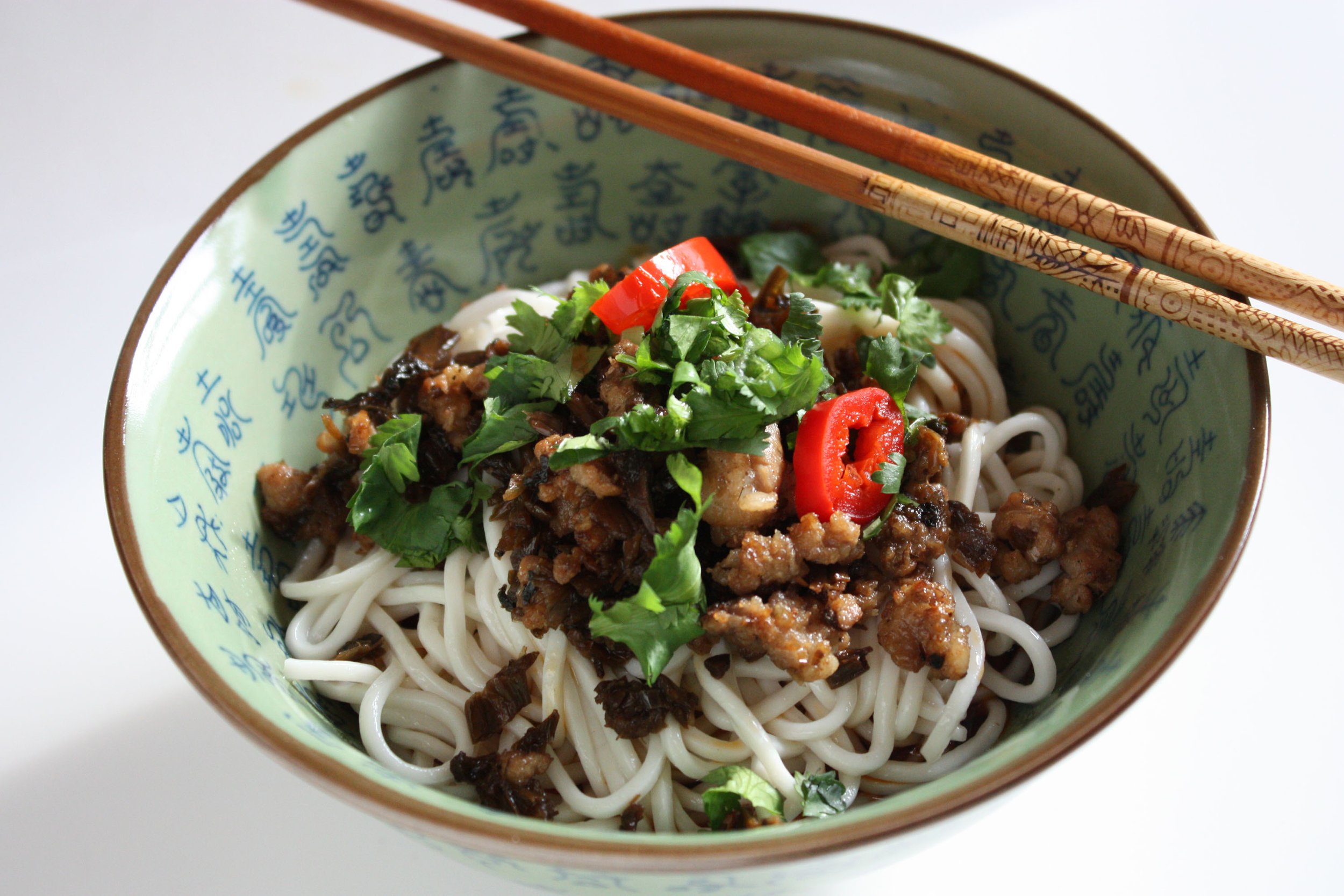February 20th: Mala Spicy Wontons and Dan Dan Noodles
February 20th: Mala Spicy Wontons and Dan Dan Noodles
Learn how to use Sichuan peppercorns with James Beard nominee and cookbook author Kian Lam Kho! On Sunday, February 20th at 6PM EST, we will be making spicy wontons and dan dan noodles. Vegetarians modifications are available.
For our third stop on our February trip around the world, we are going from Malaysia to the Chinese province of Sichuan! In this virtual cooking class, we will be making mala spicy wontons and dan dan noodles. Vegetarian substitutions are also available in the recipes.
Dumplings and noodles are two of the most popular snack foods in Chinese cooking. Although there are many examples of these snacks throughout China, Sichuan is widely acknowledged as having perfected the art of making snack food. There is a huge and vibrant street food culture in Sichuan that offers dumplings, noodles, steamed cakes, pan cakes, and many other nibbles both savory and sweet.
Mala, a numbing and spicy sensation, is the iconic flavor of the Sichuan cuisine. Created using Sichuan peppercorns and dried red chili, this delicious and addictive taste is the central theme of this class. Sichuan Spicy Wontons and Dan Dan Noodles will be made in this virtual cooking class. These dishes are beloved as snacks or courses of a meal that can be found in many restaurants.
Date: Sunday, February 20th
Start Time: 6pm Eastern/3pm Pacific
Price: $25/household
Platform: Live and interactive cooking class via Zoom
The Menu:
Mala Spicy Wontons
Dan Dan Noodles
(vegetarian modifications available for both dishes)
A bowl of spicy wontons is one of those street foods that is omnipresent for breakfast, lunch and anytime in between. The wontons are mostly pork-filled, but sometimes enriched with ingredients such as shrimp, shiitake mushrooms or bamboo shoots. The secret to this drool-inducing bowl of wontons, however, is the mala spicy sauce. The numbing and spicy heat combination that is known as mala is created by the two key ingredients - Sichuan peppercorns and red chilis. This spicy slightly sweet and tart sauce beautifully coats the wontons and elevates them from simple dumplings to a legendary delicacy.
Dan Dan Noodles
Dan dan noodles is similarly renowned as a Sichuan street food specialty. Although not so strongly mala flavored, the numbing spicy heat comes through as a subtle booster of the sesame paste sauce. These noodles have become so popular that they are now served not just in the street but in many brick and mortar restaurants.
Although the two main recipes in this class are the spicy wontons and dan dan noodles, the dishes would not be complete without a recipe for Sichuan chili oil. This chili oil can be obtained from a Chinese grocery, but it can be so very satisfying to make it at home.
In this virtual cooking class with Kian Lam Kho, you will learn:
How to make a pork and shrimp wontons
How to wrap wontons in a few different ways
How to make chili oil (Recipe will be available for making this oil before the class)
How to make mala spicy sauce for the wontons
How to make the toppings for Dan Dan Noodles
How to assemble Dan Dan Noodles for serving
Phoenix Claws and Jade Trees
Essential Techniques of Authentic Chinese Cooking by Kian Lam Kho
The Teacher: Kian Lam Kho
Kian Lam Kho is a food writer, cooking instructor and food consultant specializing in Chinese cuisine. He is the creator of the James Beard Foundation Awards nominated Chinese home cooking blog Red Cook and his first cookbook on Chinese cooking techniques, Phoenix Claws and Jade Trees: Essential Techniques of Authentic Chinese Cooking, is the recipient of the Julia Child First Book Award from IACP (International Association of Culinary Professional) in 2016. He acted as consulting chefs in menu concept design for several restaurants in New York City and Fayetteville, Arkansas as well as food services at universities in Baltimore and Boston. He teaches Chinese cooking at the Institute of Culinary Education and the Brooklyn Kitchen.
Notes on some of the ingredients:
You will need to obtain a few authentic Sichuan ingredients in order to recreate these dishes properly. Fly By Jing is a really good brand that sells Sichuan peppercorns and Sichaun Chile Crisp. Click here to see if their products are for sale near you.
Sichuan chili oil/Sichuan chili crisp: An essential ingredient, can either be purchased from a Chinese grocery or made at home. A recipe for making Sichuan chili oil at home will be provided. One example is Lao Gan Ma. You can probably find this brand at a local grocery store. Or you can order it online.
Sichuan peppercorns: Either whole or powdered, they are essential for the spicy flavor. If you get the whole peppercorns then toast them slightly in a dry wok or frying pan before grinding them in a spice grinder. Here is one online option.
Ya cai or Sichuan preserved greens: They can be replaced with Sichuan pickled mustard stems, which are more readily available in Chinatown markets. This is one option you can find online.
Chinkiang black vinegar: This is the kind you want and it is easy to find at an Asian market or online.
Shanghai style noodles: You can use fresh or dried noodles. Select the kind that’s plain flour noodles without eggs. Look for the thickness similar to spaghetti, and not udon or angel hair sizes.
Sesame paste: Similar to peanut butter, not tahini. Here is one of many available on Amazon.
Dried chili flakes:
Equipment:
Measuring spoons
Measuring cup
Small mixing bowl
Large mixing bowl
Large pot
Spider strainer
Large chef knife
Large cutting board
Wooden mixing spoon
Frying Pan or skillet
Baking sheet
Parchment paper for lining baking sheet
4 medium bowls for serving noodles
1 large bowl for serving wonton
Ingredients: exact quantities will be sent within 24 hours of purchasing the class
Square wonton wrappers
Ground Pork
Medium shrimp cut into 1/4” pieces
Scallions
Toasted sesame oil
Cornstarch
Salt
Ground white pepper
Sichuan Chili oil (store-bought or you can make this before class with the provided recipe)
Soy sauce
Chinkiang black vinegar
Garlic
Ginger
Sugar
Shanghai style noodles
Cilantro
Vegetable oil
Sichaun preserved mustard greens (ya cai) or pickled kohlrabi (zha cai)
Shaoxing cooking wine
Sesame paste
Dried Chili flakes
Ground Sichuan peppercorns
If making your own Sichuan chili oil:
Sichuan peppercorns
Cloves
Cassia bark (aka Chinese cinnamon)
star anise
black cardamom
If you are vegetarian, you will need these substitutes:
Firm tofu
zucchini
wood ear mushrooms
Asian eggplant
all-purpose flour
five spice powder



